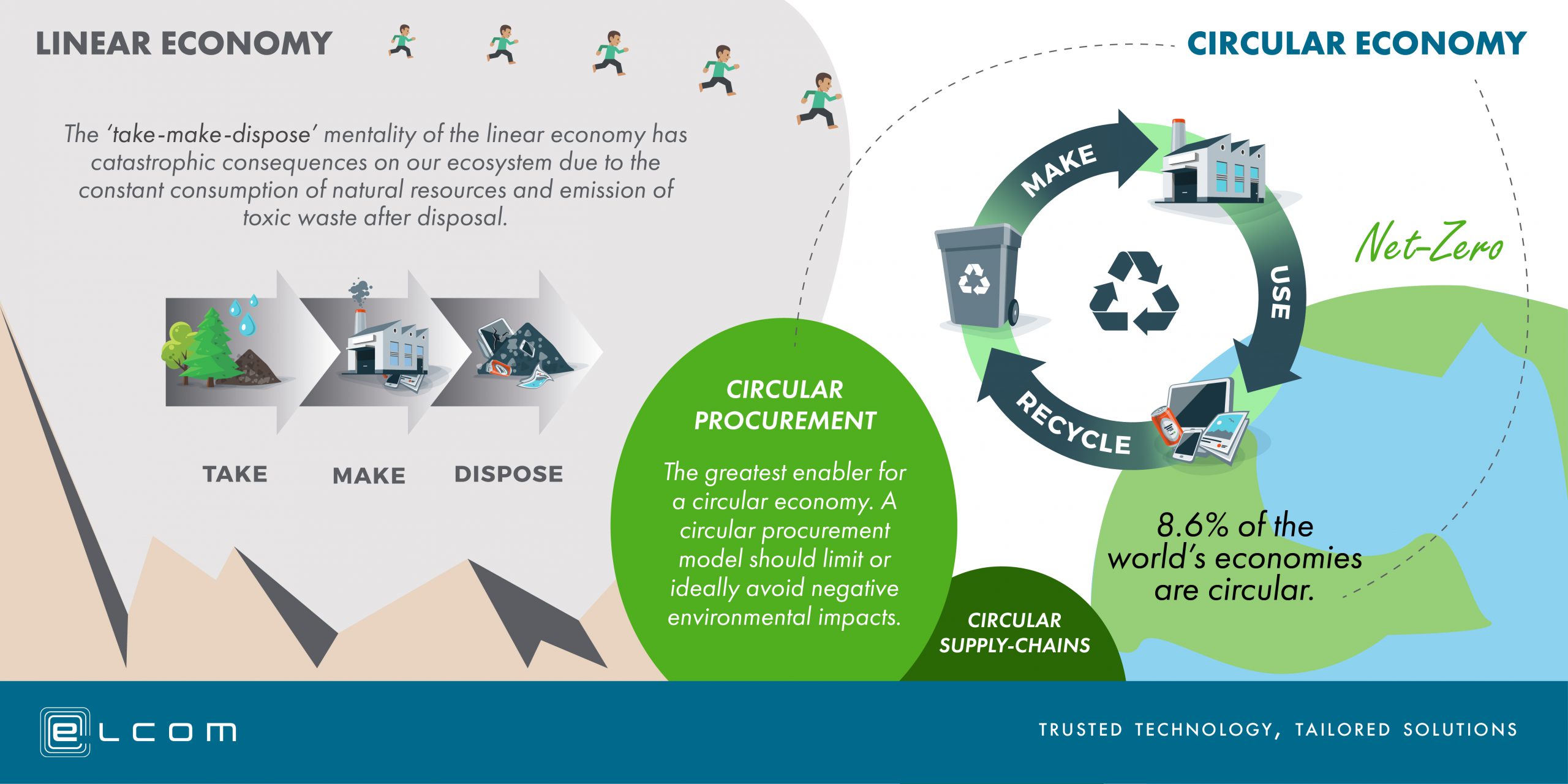For our planet to survive, global circular economies need to increase to 17%. A circular economy is one in which goods and raw materials are reused, recycled, or repurposed for as long as possible to minimise waste. Currently, only 8.6% of the world’s economies are circular, and hence rapid change is essential to secure our future.
In a linear economic model, only a fraction of waste is reused or recycled. Many materials, including rare or valuable ones, end up in landfills or incinerated. The ‘take-make-dispose’ mentality of the linear economy has catastrophic consequences on our ecosystem due to the constant consumption of natural resources and emission of toxic waste after disposal. This has led to a global climate emergency, and the adoption of circular economy and circular public procurement is now crucial.
What is a circular economy?
A circular economy aims to tackle global issues like climate change, waste, and pollution. Within a circular economy, the value a material or substance loses over time is reduced. This is achieved through reusing, recycling, or refurbishing existing materials and products by using renewable energy sources. It’s estimated that circular opportunities in China could reduce the consumption of non-renewable resources by 71% by 2040. Unlike a linear economy, a circular economy aims to keep infrastructure, materials, and products in circulation for their maximum lifespan, enhancing their productivity.
What is the difference between recycling and circular economy? Recycling begins at the end – the ‘get-rid’ stage of a product’s lifecycle. The circular economy, however, goes right back to the beginning to prevent waste and pollution from being created in the first place. In the face of our current enviromental challenges, recycling won’t be enough to overcome the sheer amount of waste we produce.
“In a propertly built circular economy, one should rather focus on avoiding the recycling stage at all costs”
Source: World Economic Forum
What is circular procurement?
Circular procurement is the greatest enabler for a circular economy. In the case of public procurement, this relates to public authorities purchasing goods and services or investing in public projects, that minimize waste. A circular procurement model should limit or ideally avoid negative environmental impacts. In 2013, the city of Turin introduced changes to its school catering offer by introducing reusable plates instead of disposable ones. This change alone has significantly reduced plastic waste by 157 tonnes per year since then.
The advantages of circular procurement
Circular procurement is a key step towards increasing sustainability. It’s instrumental to working towards targets for net-zero emissions. The UN’s current goal is to secure net-zero emissions globally by mid-century. The COP26 conference taking place in Glasgow, Scotland during October – November 2021, is a significant step that aims to action against climate change, pushing for more public bodies to adopt a circular procurement model.
Beyond sustainability, individual communities benefit from circular public procurement. Increased demand for sustainable goods and services means new industries are needed to source and repurpose renewable resources, which further leads to job creation. The European Commission estimates that the circular economy directly created 3.9 million extra jobs. Additionally, resources are likely to be lower cost and longer-lasting because they’re designed to be reused.
Examples of circular procurement
Scottish Procurement and Zero Waste Scotland are making strides towards circular procurement. To move towards this model, Zero Waste Scotland has opted to repair or upgrade existing products rather than replace them. They are also ensuring that existing assets are utilised effectively. Zero Waste Scotland is increasingly using technology to monitor assets usage and plan servicing and maintenance.
Another example is the Senate Department for Environment, Construction, and Transport in Bremen, Germany. In 2013, the Department lowered its emissions and expenditure by replacing its fleet of vehicles with membership to a car-sharing service. 11 of its vehicles that had allowed usage rates were switched to a car-sharing service. This increased access to efficient vehicles, including electric cars, and reduced parking fees and vehicle maintenance costs.
With populations growing across the globe, communities are finding it harder to find sufficient resources and manage waste and emissions, meaning that alternative solutions are vital. Circular economies and circular procurement models are invaluable for finding a way forward.

